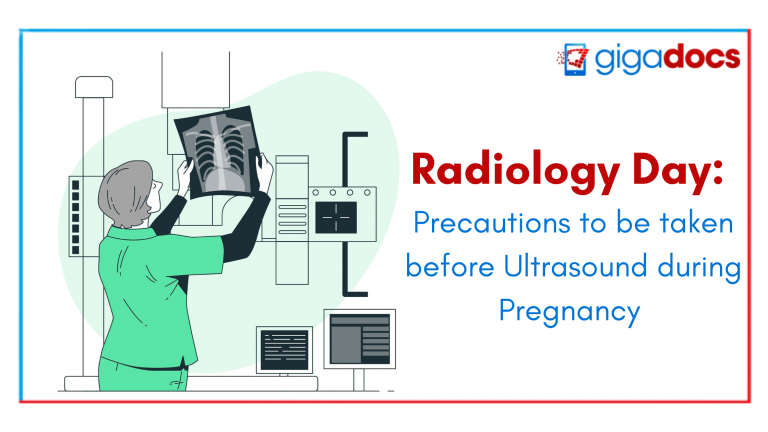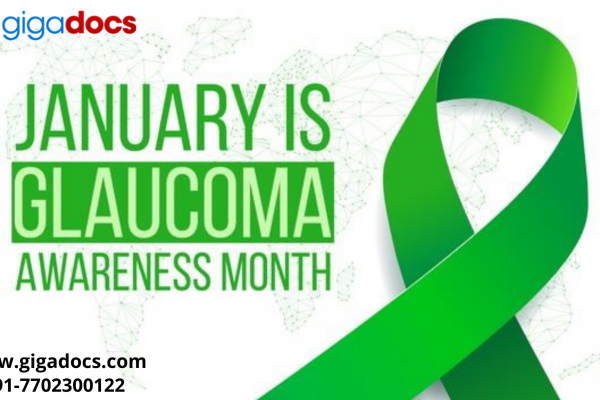Radiology is essential in disease management; its imaging diagnosis provides specific details about structural or disease-related changes, and early detection can save countless lives.
The International Day of Radiology will be on the 8th of November. Gigadocs recognizes radiology’s critical role in ensuring earlier detection, fewer surgeries, and better patient treatment outcomes. This Radiology Day, learn about the precautions pregnant women must take when undergoing ultrasound scans.
During Pregnancy Ultrasound
Seeing your baby for the first time on a monitor screen can be an emotional and moving experience; however, ultrasounds are important for reasons other than the take-home photograph. They can assist in tracking fetal development, screening for abnormalities such as Down syndrome, and monitoring your baby’s health – but what are the different types of scans, and when do you need them? Let us explain-
- The Dating Scan
Between 8 and 14 weeks of pregnancy, you will have your first ultrasound scan to determine when your baby will be born. The sonographer will estimate the date of birth based on your baby’s measurements. They will check if the baby is growing in the right place if there are multiple babies, and how far your baby has grown during this scan.
- The Gender Scan
Expectant parents can learn the gender of their unborn child through an ultrasound scan as early as 14 weeks, provided during your 20-week scan.
- The Mid-Pregnancy Scan
The mid-pregnancy scan, also known as an ‘anomaly scan,’ is performed between weeks 18 and 20 of pregnancy. The sonographer examines the baby for structural and developmental abnormalities during this scan. Your doctor may even offer you HIV, syphilis, and hepatitis B screenings during this scan appointment.
- Third-Trimester Scans
In some cases, the doctor may recommend a third-trimester scan based on the results of previous tests, complications, or pre-existing medical conditions. Third-trimester scans can be used to check your baby’s growth (a growth scan), as well as the activity of the placenta, monitor your baby’s heartbeat (a Doppler scan), and assess your baby’s position.
- Standard 2D Scans
The typical ultrasound test performed in hospitals and clinics is two-dimensional. Traditional 2D ultrasound creates flat, outlined images through which you can see your baby’s internal organs and detect any internal issues. The sonographer can use these black-and-white images to determine the baby’s gestation, growth, heartbeat, development, and size.
- 3D Scans
Some expecting mothers prefer a 3D ultrasound scan because it provides a more realistic image of the baby. Between 26 and 30 weeks of pregnancy, you can have a 3D scan, which allows your doctor to see your baby’s width, height, and depth. 3D ultrasound scans provide still images of your baby’s external body rather than its insides, allowing you to see the shape of the baby’s facial features.
- 4D Scans
4D ultrasound scans are similar to 3D scans in that they display moving videos rather than still images and a clear image of the baby’s face and movements. 3D and 4D ultrasound scans can be requested starting at 26 weeks of pregnancy.
- Transvaginal Ultrasound Scans
Internal structures are examined using a transvaginal ultrasound scan. It entails inserting a small probe into the vagina and is most commonly used in the early stages of pregnancy when capturing a clear image externally is difficult.
- Fetal Echocardiography
If doctors suspect your baby has a congenital heart defect, they may perform fetal echocardiography. This ultrasound scan provides an in-depth image of your baby’s heart’s size, shape, and structure, which can aid in diagnosing heart problems.
Benefits of Ultrasound During Pregnancy
Ultrasound can be used at several stages of pregnancy, including:
- First Trimester – During the first three months of pregnancy, ultrasound is used to confirm that the embryo is developing inside the womb (rather than in a fallopian tube, for example), confirm the number of embryos, and calculate the gestational age and due date.
- Second Trimester – Between weeks 18 and 20, ultrasound is used to monitor the development of fetal structures such as the spine, limbs, brain, and internal organs. The size and position of the placenta are also examined.
- Third Trimester – After 30 weeks, an ultrasound is done to ensure that the baby is still growing normally. The position of the placenta is checked to ensure that it is not in the cervix.
Precautions that Pregnant Women Must Take During Ultrasound
Ultrasound is a non-invasive, painless procedure. Many parents view the ultrasound as a chance to see their unborn child and possibly learn its gender. However, keep in mind that an ultrasound is a diagnostic procedure, which may indicate that a fetus has an abnormality in some cases. Let’s read what the precautions expectant mothers are, and their caregivers must take post an ultra scan-
- Taking care at home
An ultrasound scan is a painless and non-invasive procedure. It requires no special precautions afterward. You may resume your normal activities.
- Care in the long term
What happens next is determined by the ultrasound results. It is important to note that a normal result does not guarantee that your baby is normal, as some abnormalities cannot be detected using this test. Additional tests may be required to confirm the diagnosis if fetal abnormalities are discovered. Before deciding whether or not to proceed, discuss these tests’ benefits, risks, and complications with your doctor.
How to Prepare for a Pregnancy Ultrasound
- A full bladder is essential for the ultrasound exam. Empty your bladder 90 minutes before the exam, then drink one 8-ounce glass of fluid (water, milk, coffee, etc.) an hour before the exam.
- You can eat before the fetal ultrasound.
- For your comfort, Gigadocs recommends wearing a two-piece outfit so that we can access your abdomen without you having to remove your clothing.
Pregnancy Care with Gigadocs
All ultrasound scans are safe and have a very low risk. They can be done for medical and non-medical reasons, but medical professionals do not advise unnecessary exposure to ultrasound waves. The average number of ultrasounds varies from pregnancy to pregnancy and is determined by the results of your initial tests and scans.
Gigadocs offers a pregnancy package that allows you to monitor your baby before birth. If you want to learn more about ultrasound scans or make an appointment to consult Gynecologists & Obstetricians, and sonographers, download the Gigadocs app and get in touch-
To download the Gigadocs App:
- IOS App – apple.co/2W2iG4V
- Android App – bit.ly/33AQoRC
To know more e-mail, at info@gigadocs.com




